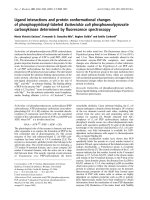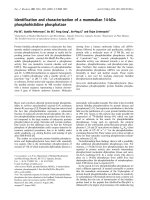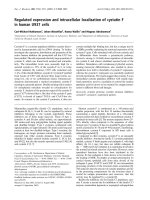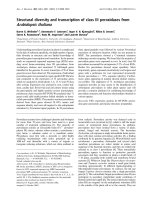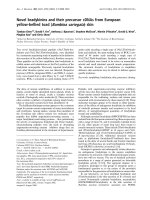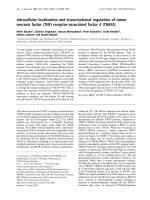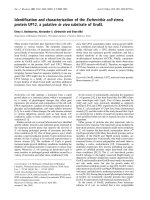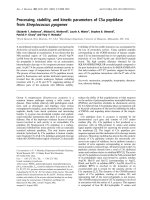Báo cáo y học: "Shunsei Hirohata and Hirotoshi Kikuchi" pps
Bạn đang xem bản rút gọn của tài liệu. Xem và tải ngay bản đầy đủ của tài liệu tại đây (83.16 KB, 8 trang )
139
HSP = heat shock protein; IFN = interferon; IL = interleukin; MHC = major histocompatibility complex; MIC-A = MHC class I chain-related gene A;
Th1 = T helper cells type 1; TNF-α = tumor necrosis factor alpha.
Available online />Introduction
Behçet’s disease is characterized by recurrent aphthous
stomatitis, uveitis, genital ulcers, and skin lesions. Since
vascular manifestations are common in this disease, it is
regarded as vasculitis. However, the predominant
histopathological features in the inflamed tissues are infil-
tration of lymphocytes and monocytes, and sometimes
polymorph nuclear leukocytes, through small veins
without microscopic changes in the vessel walls. Throm-
bophilia or thrombophlebilis involving small and large
veins is also common, whereas arteritis is rare. In these
regards, Behçet’s disease is unique compared with other
vasculitides.
The clinical characteristics of Behçet’s disease are the
recurrent episodes of remission and the exacerbation of
various symptoms. Chronic sustained inflammation in
certain tissues is rare. Recurrent uveitis attacks usually
result in the loss of vision that affects profoundly the activ-
ity of daily life of the patients. The involvement of the vas-
cular system, of the intestinal system, and of the central
nervous system is usually life threatening.
The etiology and pathogenesis of Behçet’s disease have
not been fully clarified. However, recent investigations
have made significant progress in these areas. Moreover,
increasing attention has been paid to the effect of anti-
tumor necrosis factor alpha therapy in this disease. The
present article overviews an update on the etiology, patho-
genesis, clinical manifestation, and treatment of Behçet’s
disease.
Etiology and pathogenesis
Genetics
Behçet’s disease has higher prevalence in the countries
along the ancient ‘Silk Road’ from Japan to the Mediter-
ranean region. A number of studies have provided evi-
dence that HLA-B51 is strongly associated with the
disease in different ethnic groups [1]. It has been dis-
cussed, however, whether HLA-B51 participates in the
disease due to a linkage disequilibrium with a nearby gene
[2], since the positive ratio of HLA-B51 in Behçet’s
disease patients is only approximately 60% [3].
Mizuki’s group recently proposed that the critical region
for Behçet’s disease in the human major histocomaptibility
complex (MHC) gene could be pinpointed to a 46-kb
segment between the MHC class I chain-related gene A
(MIC-A) gene and the HLA-B gene [4]. The MIC-A gene
is a highly polymorphic member of MHC class I chain
Review
Behçet’s disease
Shunsei Hirohata and Hirotoshi Kikuchi
Department of Internal Medicine, Teikyo University School of Medicine, Tokyo, Japan
Corresponding author: Shunsei Hirohata (e-mail: )
Received: 17 Jan 2003 Revisions requested: 24 Feb 2003 Revisions received: 6 Mar 2003 Accepted: 11 Mar 2003 Published: 2 Apr 2003
Arthritis Res Ther 2003, 5:139-146 (DOI 10.1186/ar757)
© 2003 BioMed Central Ltd (Print ISSN 1478-6354; Online ISSN 1478-6362)
Abstract
Behçet’s disease is characterized by recurrent aphthous stomatitis, uveitis, genital ulcers, and skin
lesions. The role of the HLA-B*51 gene has been confirmed in recent years, although its contribution
to the overall genetic susceptibility to Behçet’s disease was estimated to be only 19%. The production
of a variety of cytokines by T cells activated with multiple antigens has been shown to play a pivotal role
in the activation of neutrophils. As regards the treatment, anti-tumor necrosis factor alpha therapy has
been shown to be effective for mucocutaneous symptoms as well as for sight-threatening panuveitis,
although a randomized, controlled trial is required.
Keywords: HLA-B51, neutrophil, T lymphocytes, treatment, tumor necrosis factor alpha
140
Arthritis Research & Therapy Vol 5 No 3 Hirohata and Kikuchi
(MIC), with more than 20 alleles in terms of amino acid
variation in the α1 (exon 2), α2 (exon 3), and α3 (exon 4)
domains [5]. MIC-A encodes a cell surface glycoprotein
that is not associated with β
2
-microglobulin, that lacks a
CD8 binding site, and that is conformationally stable inde-
pendent of conventional class I peptide ligands [5]. MIC-A
is expressed in a variety of cells, and its expression is reg-
ulated by promoter heat shock elements similar to those of
hsp70 genes [5]. Analysis of MIC-A genotyping revealed
that the frequency of the MIC-A009 allele, coding the
extracellular domains of MIC-A, was greatly increased in
Japanese patients with Behçet’s disease [5]. Stratification
and linkage analyses between MIC-A009 and HLA-B51,
however, disclosed that the real disease susceptibility
gene in Behçet’s disease is the HLA-B*51 allele itself.
Moreover, MIC-A009 was found to be strongly associated
with HLA-B51 as well as HLA-B52, which was not
increased in Behçet’s disease. It was therefore concluded
that the significant increase of the MIC-A009 allele in the
Japanese patients is due to a strong linkage disequilibrium
with the HLA-B*51 allele [5].
Similar findings on the linkage disequilibrium between the
HLA-B*51 allele and the MIC-A allele have been reported
in ethnic groups other than Japanese patients [6]. It has
thus been disclosed that strong association of the MIC-A
A6 allele of the transmembrane region of MIC-A with
Behçet’s disease results from a strong linkage disequilib-
rium with the HLA-B*51 allele.
Twenty-four different HLA-B*51 alleles (HLA-B
*
5101–
HLA-B*5124) have now been described. It was therefore
possible that there might be disease-specific polymor-
phisms or mutations within the HLA-B*51 genes.
However, analysis with sequencing of the HLA-B*51
genes from Behçet’s disease patients and from healthy
individuals failed to disclose the difference in the exonic
nucleotide sequences [7]. Moreover, no disease-specific
polymorphisms or mutations within the HLA-B*51 intronic
and promoter/enhancer regions could be associated with
Behçet’s disease, although there were single nucleotide
polymorphisms in these regions both in patients and in
controls [7]. These data therefore demonstrated that the
HLA-B exonic sequence that encodes the HLA-B*51
allele is the real pathogenic factor in Behçet’s disease.
This observation in a Japanese population has also been
confirmed in different ethnic groups [8].
Gül et al. confirmed the genetic linkage of the HLA-B gene,
but not the MIC-A gene, with Behçet’s disease using the
transmission disequilibrium test [9]. However, the highest
contribution of HLA-B to the overall genetic susceptibility
to Behçet’s disease was estimated to be only 19% in an
analysis of a small group of multicase families [9]. This is
consistent with the fact that the positive ratio of HLA-B51
in Behçet’s disease is approximately 60% [3]. Identification
of other susceptibility loci should thus be required. On the
contrary, a lower rate of recombination has been observed
within the extended MHC region telomeric to the HFE
gene, which caused hereditary hemochromatosis, and
strong linkage disequilibrium is a feature of this part of the
genome [10,11]. Gül et al. have provided evidence of a
novel susceptibility locus for Behçet’s disease at position
D6S285 in 6p22-p23, ~17 cM telomeric to the HLA-B*51
locus, in a linkage study in 28 multicase Turkish families
using highly polymorphic microsatellite markers [12]. The
identification of the gene in this novel susceptibility locus
will make a great contribution to our understanding of the
pathogenesis of Behçet’s disease.
As regards non-MHC genes, increasing attention has
been paid to the mutation of the MEFV gene. This gene is
linked to familial Mediterranean fever, which has similari-
ties to Behçet’s disease in both epidemiology and mani-
festations. Some mutations in the MEFV gene have been
implicated in Behçet’s disease, suggesting that they might
act as additional susceptibility factors in Behçet’s disease
[13]. Further studies to delineate the frequency of MEFV
gene mutations in Behçet’s disease patients in Japan,
where familial Mediterranean fever is extremely rare, would
be important to confirm the association of the MEFV muta-
tion with the susceptibility of Behçet’s disease.
HLA-B*51 is currently the only gene that has been shown
to be linked with susceptibility to Behçet’s disease. No
HLA-B51 restriction of certain peptide antigens has been
demonstrated, however, rather obviating the possibility
that HLA-B51 might be involved in antigen presentation.
HLA-transgenic animal models are quite helpful to explore
the relationship between HLA and disease. The occur-
rence of spontaneous inflammatory disease was thus
demonstrated in transgenic rats expressing HLA-B27 and
human β
2
-microglobulin genes [14]. In this regard, it was
interesting that a HLA-B*5101 heavy chain transgenic
mouse was developed [15]. However, the animal did not
develop Behçet’s disease-like manifestations, although it
did show a very modestly increased neutrophil activity fol-
lowing f-Met-Leu-Phe stimulation compared with control
mice [15]. It would be also interesting to try to establish
transgenic animal models of HLA-B51 and β
2
-microglobu-
lin in order to explore the role of HLA-B51 in the patho-
genesis of Behçet’s disease, since there are some
similarities in clinical manifestations between Reiter’s syn-
drome and Behçet’s disease.
Immunopathogenesis
The pathergy reaction is a unique feature of Behçet’s
disease and might be closely related to the pathogenesis. It
has been shown that the early pathergy reaction at 4 hours
is mediated by neutrophils and lymphocytes without vasculi-
tis, with the rapid accumulation of neutrophils at the needle-
prick sites [16]. The dermis at 48 hours of the pathergy
141
reaction was infiltrated predominantly by mononuclear cells
composed mainly of T lymphocytes and monocytes/
macrophages, with neutrophils constituting less than 5% of
the infiltrating cells [17]. It is thus suggested that hyper-
chemotaxis of neutrophils might play a role in triggering the
reaction, whereas activated T lymphocytes are required for
the development of the whole pathergy reaction.
The therapeutic efficacy of cyclosporin A in uveitis of
Behçet’s disease [18] strongly suggests the involvement
of T-cell activation in the pathogenesis of this disease. On
the contrary, attention was paid to the role of certain
strains of streptococci as an etiologic agent. Patients with
Behçet’s disease have a significantly higher incidence of
tonsillitis and dental caries. Systemic symptoms of
Behçet’s disease could thus be induced after treatment of
dental caries or even by intracutaneous injection of the
streptococcal antigens [19]. Accordingly, Streptococcus
sanguis-related antigens KTH-1 stimulated in vitro produc-
tion of IL-6 and IFN-γ by T cells from patients with
Behçet’s disease [20]. However, Escherichia coli-derived
antigens also enhanced the in vitro production of IFN-γ by
T cells from the patients, obviating the possibility that
T-cell hypersensitivity in Behçet’s disease might be spe-
cific for streptococcus-related antigens [20].
Lehner and colleagues explored the response of T cells
from patients with Behçet’s disease to mycobacterium
65-kDa heat shock protein (HSP), since it was disclosed
that serum IgA antibodies to the mycobacterial 65-kDa
HSP were elevated in Behçet’s disease and that a number
of monoclonal antibodies of the mycobacterial 65-kDa
HSP cross-reacted with selected strains of S. sanguis
[21]. They showed that four peptide determinants within
the mycobacterial 65-kDa HSP (and the corresponding
human HSP peptides) stimulated significantly higher lym-
phoproliferative responses in Behçet’s disease, as com-
pared with the related disease, unrelated disease, and
healthy controls [21]. Lehner and colleagues further char-
acterized that the four mycobacterial 65-kDa HSPs and
corresponding peptides from human 60-kDa HSP elicited
significant γδ T-cell responses in Behçet’s disease, as
compared with controls [22]. They claimed that T-cell
recognition of certain 60-kDa HSP peptides by γδ T cells
might be important in the pathogenesis of the disease [22].
Lehner and colleagues also postulated that an immune
response to the streptococcal HSP might also be directed
to epithelial and other human 60-kDa HSPs, although there
was the lack of specificity. It is thus possible that antigens
other than these HSP-related peptides might be involved in
the pathogenesis of Behçet’s disease.
Supporting the role of γδ T cells in the pathogenesis of
Behçet’s disease, Freysdottir et al. provided evidence for
the increased proportion of peripheral blood γδ T cells in
Behçet’s disease compared with both recurrent aphthous
stomatitis and healthy controls [23]. These γδ T cells
expressed activation markers, such as CD25, CD69, and
CD29, and produced the inflammatory cytokines IFN-γ
and tumor necrosis factor alpha (TNF-α) [23].
It has been reported that high numbers of γδ T cells, pre-
dominantly Vγ9Vδ2 T cells producing IFN-γ, were recov-
ered from intraocular fluid of Behçet’s disease patients but
not from control patients [24]. These Vγ9Vδ2 T cells
responded to isopentyl pyrophosphate and related non-
peptide prenyl pyrophosphates, but not to 65-kDa HSP
[24]. Isopentyl pyrophosphate and related prenyl
pyrophosphates are essential metabolites for both
prokaryotic and eukaryotic cells [25]. It has therefore been
suggested that ubiquitous antigens of microbial origin may
trigger cross-reactive autoimmune responses in Behçet’s
disease [25]. The increase in Vγ9Vδ2 T cells has been
also found in the peripheral blood of patients with
Behçet’s disease [26]. These results, however, do not
necessarily indicate the specific activation of Vγ9Vδ2
T cells, since human peripheral blood γδ T cells mainly
express Vγ9Vδ2 [27]. It is thus possible that the increase
in Vγ9Vδ2 T cells might simply reflect the larger fraction of
this subset within the pool of γδ T cells.
The γδ T cells account for only 2–5% of peripheral blood
T cells in humans. The importance of αβ T cells in the
pathogenesis of a variety of autoimmune diseases has
thus been implicated. In this regard, oligoclonal expansion
of peripheral blood αβ T cells has been demonstrated in
30–50% of patients with Behçet’s disease [28,29]. Since
most of the T-cell expansions were reduced in correlation
with ameliorated disease activity, a possible involvement
of antigen-specific T cells in the pathogenesis was sug-
gested [29]. It is probable that antigen-specific T-cell
responses might drive an attack of a variety of symptoms
in Behçet’s disease. Of note, positive skin reactions to
streptococcal-related antigens as well as E. coli-derived
antigens and Klebsiella pneumoniae-derived antigens
were frequently observed in Behçet’s disease [19]. It is
thus possible that patients with Behçet’s disease might be
hypersensitive to multiple antigens rather than to a certain
single antigen. In fact, although the oligoclonal T-cell
expansions have been reported in an exacerbation phase
of Behçet’s disease, the recurrent expansion of the same
T-cell clone in each attack has not been demonstrated in
longitudinal courses of Behçet’s disease.
It is postulated alternatively that T cells in Behçet’s
disease are hypersensitive to a variety of antigens. In this
regard, we have demonstrated that T cells from Behçet’s
disease patients were stimulated to produce IFN-γ with
very low concentrations of staphylococcal enterotoxin B
and SEC1 that were not able to stimulate T cells from
normal individuals or control patients (rheumatoid arthritis)
[30]. Since there were no significant differences between
Available online />142
Behçet’s disease T cells and control T cells in monocyte-
independent or monocyte-dependent IFN-γ production
stimulated with low or high concentrations of anti-CD3, it
was suggested that abnormalities in signal transduction
triggered by perturbation of T-cell receptors, but not in
that induced by cross-linking of CD3 molecules, might
play an important role in the pathogenesis of Behçet’s
disease [30]. It should be emphasized that our results do
not indicate that the superantigen effects are involved in
the pathogenesis of Behçet’s disease, but that they
emphasize the role of hypersensitive signaling through
T-cell receptors. Abnormal signal transduction through
T-cell receptors might thus explain the hypersensitivity of
γδ T cells to 65-kDa HSP or to prenyl pyrophosphates.
Since monocytes from Behçet’s disease patients could
not result in hypersensitivity of control T cells to various
antigens [30], it is probable that abnormalities in T cells,
but not those in monocytes, play a role.
The increased production of IFN-γ has been demonstrated
in Behçet’s disease. Accordingly, peripheral Th1 cells
were significantly increased in active Behçet’s disease
[31]. Moreover, serum IL-12 levels were found to be corre-
lated with peripheral Th1 cells and disease progression
[31], although the mechanism of increased IL-12 produc-
tion in Behçet’s disease remains unclear. Frassanito et al.
postulated that active Behçet’s disease might possibly be
a disease of antigen-presenting cells, and that T cells may
be ‘innocent bystanders’, since the elevation of IL-12
appeared to be crucial in the pathogenesis [31]. It should
be emphasized, however, that hypersensitivity of T cells
that lead to T-cell activation might account for the activa-
tion of antigen-presenting cells through CD40–CD154
interactions to produce IL-12. In addition, monocytes from
Behçet’s disease patients could not result in hypersensi-
tivity of control T cells to various antigens [30]. It would
therefore be misleading to conclude that the deviation to
Th1 responses in Behçet’s disease is due to abnormalities
in antigen-presenting cells.
It has recently been shown that active Behçet’s disease
has a higher number of CD4
+
T cells containing IFN-γ
and CD40 ligand, which are characteristics of Th1 cells
[32]. Of note, the elevation of IL-17 in the sera of
Behçet’s disease has been demonstrated [32]. On the
contrary, the production of IL-8, a cytokine that activates
neutrophils, by T cells is enhanced in Behçet’s disease
[33,34]. It should be pointed out that expression of
IL-17 has been detected almost exclusively in activated
CD4
+
and CD8
+
T cells [35]. More importantly, IL-17
has been shown to selectively recruit neutrophils to the
sites of inflammation [35]. These results suggest that
abnormalities in T-cell responses result in hyperreactiv-
ity of neutrophils in Behçet’s disease through the pro-
duction a variety of cytokines, including IL-8 and IL-17.
It is therefore strongly suggested that neutrophil activa-
tion might be sequelae of hypersensitivity of T cells in
Behçet’s disease.
The immunopathogenesis that is currently postulated is
shown in Fig. 1. Primarily, hypersensitivity of T cells (αβ
T cells and γδ T cells) to multiple antigens appears to play
a critical role in the pathogenesis. The activation of mono-
cytes subsequent to T-cell activation through
CD40–CD154 interactions as well as a variety of T-cell-
derived cytokines (IFN-γ and TNF-α) may result in the pro-
duction of IL-12, which leads to the shift to Th1
responses. In consequence of abnormal T-cell activation,
neutrophil activation may be triggered by cytokines such
as IL-8, IL-17, IFN-γ, and TNF-α. Whereas the roles of co-
stimulation molecules have not been fully explored in
Behçet’s disease, the presence of anti-CTLA-4 antibody
has been reported in a fraction of Behçet’s disease
patients [36]. Although the presence of this antibody
might be possibly involved in abnormal T-cell responses,
the antibody might be produced only as a secondary phe-
nomenon of recurrent T-cell activation in Behçet’s disease.
Clinical manifestations
Vasculo-Behçet’s disease
Involvement of veins and arteries in Behçet’s disease is
usually called vasculo-Behçet’s disease. Venous thrombo-
sis appeared to be the major vascular involvement in
7–33% of patients with Behçet’s disease, and represents
85–93% of vasculo-Behçet’s disease [35]. Deep vein
thrombosis was significantly associated with the male
gender and a positive pathergy test [37].
Arthritis Research & Therapy Vol 5 No 3 Hirohata and Kikuchi
Figure 1
Proposed model of the pathogenesis in Behçet’s disease. Ag, antigen;
APC, antigen-presenting cells; HSP, heat shock protein; IFN,
interferon; IL, interleukin; IPP, isoprenyl pyrophosphate; PPP, prenyl
pyrophosphate; TCR, T-cell receptor; Th1, T helper cells type 1;
TNF-α, tumor necrosis factor alpha.
IL-12
TCR - Abnormal Signaling
CD40
CD154
TNF-α
IL-8
Tissue Injury
IL-8, IL-17
TNF-α
IFN-γ
APC
Multiple bacterial Ag
IPP, PPP
HS
P
T cell hypersensitivity
Th1 dominant
responses
Neutroph
il Activation
Monocyte
TNF-α
IFN-γ
143
A number of studies have explored the pathogenesis of
thrombophilia in Behçet’s disease. Neither deficiency in
protein C, in protein S, in factor V Leiden and in antithrom-
bin III nor resistance to activated protein C and anticardi-
olipin antibody levels seemed to be correlated with vascular
thrombosis in Behçet’s disease [37,38]. There were
increased thrombin generation, fibrinolysis, and thrombo-
modulin in Behçet’s disease, but these abnormalities were
not related to thrombosis [38]. These results therefore
suggest that thrombophilia in Behçet’s disease might be
related more to inflammation than to clotting disorder.
Recent studies have disclosed the occurrence of anti-
endothelial cell antibodies in Behçet’s disease [39]. It has
been demonstrated, moreover, that increased E-selectin
expression was observed when endothelial cells were
incubated with sera from patients with active Behçet’s
disease or with sera from patients with anti-endothelial
cell antibodies and high levels of myeloperoxydase, or
with purified myeloperoxydase itself [39]. Since neutro-
phils from active Behçet’s disease release increased
amounts of myeloperoxydase [39], it is probable that
neutrophil activation as well as the expression of anti-
endothelial cell antibodies might play an important role in
the development of endothelial inflammatory damages,
leading to thrombophilia.
Arterial involvement, although rare, does occur in Behçet’s
disease. The arterial manifestations in Behçet’s disease
resemble those of Takayasu’s arteritis, including arterial
occlusion and aneurysm formation. Histopathological
studies revealed that the number of vasa vasorum with
infiltration of neutrophils and lymphocytes was significantly
increased in vasculo-Behçet’s disease compared with in
Takayasu’s arteritis and other inflammatory aneurysms
[40]. It was therefore suggested that arterial involvement
in vasculo-Behçet’s disease might be caused by a neu-
trophilic vasculitis targeting the vasa vasorum, leading to
degeneration of the arterial wall [40].
Neuro-Behçet’s syndrome
The neurological involvement in Behçet’s disease is either
caused by primary neural parenchymal lesions (neuro-
Behçet’s syndrome) or is secondary to major vascular
involvement [41,42]. The latter type is rarely complicated
with the parenchymal lesions and should be called
vasculo-Behçet’s disease [41]. This vasculo-Behçet’s
disease type generally has a better prognosis compared
with the parenchymal type [41].
The most commonly involved area in neuro-Behçet’s syn-
drome is the brain stem, but spinal cord lesions, hemi-
sphere lesions and meningoencephalitis also occur [42].
Among a variety of signs and symptoms, pyramidal tract
signs are most frequently observed [41,42]. Although a lot
of efforts have been made, the etiology and pathogenesis
of neuro-Behçet’s syndrome still remain unclear. In addi-
tion, factors determining prognosis and appropriate treat-
ment have not been delineated.
We have recently disclosed that neuro-Behçet’s syndrome
can be classified as acute type and as chronic progressive
type [43]. Acute neuro-Behçet’s syndrome is character-
ized by acute meningoencephalitis with or without focal
lesions, presenting high-intensity areas in T2-weighted
images or fluid attenuated inversion recovery (FLAIR)
images on magnetic resonance imaging scans [43].
Cyclosporin A is frequently associated with acute neuro-
Behçet’s syndrome, at least among the Japanese patients
[44]. Acute neuro-Behçet’s syndrome responds to steroid
therapy, and is usually self-limiting.
By contrast, the chronic progressive type of neuro-
Behçet’s syndrome is characterized by intractable, slowly
progressive dementia, ataxia and dysarthria, with persis-
tent elevation of cerebrospinal fluid IL-6 activity
(> 20 pg/ml) [45]. Most patients (approximately 90%) in
our series with the chronic progressive type of neuro-
Behçet’s syndrome were HLA-B51-positive, and they had
history of attacks of acute type neuro-Behçet’s syndrome
prior to the development of progressive neurological
symptoms [45].
It should therefore be pointed out that the two types of
neuro-Behçet’s syndrome are currently considered to rep-
resent different stages rather than independent clinical
entities. In fact, we have recently experienced some
patients who displayed prolonged elevation of cere-
brospinal fluid IL-6 activity following the acute type neuro-
Behçet’s syndrome. It is therefore suggested that the
appropriate treatment of such patients can prevent pro-
gression of neurological symptoms, although further studies
are required to confirm this point. Of note, chronic progres-
sive neuro-Behçet’s syndrome is resistant to conventional
treatment with corticosteroid, with cyclophosphamide, or
with azathioprine. Recent studies, however, suggest the effi-
cacy of low-dose weekly methotrexate in the chronic pro-
gressive type of neuro-Behçet’s syndrome [46].
Treatment
Abnormal activation of neutrophil functions has been rec-
ognized in the pathogenesis of Behçet’s disease [47].
Colchicine has been widely used as a basic drug for treat-
ment of Behçet’s disease based on the claim that
colchicine exerts beneficial effects through inhibition of
neutrophil functions [47]. The results of a 2-year random-
ized, double-blind, placebo-controlled study have recently
demonstrated that colchicine significantly reduced the
occurrence of arthritis in both female and male patients,
whereas it reduced the occurrence of genital ulcers and
erythema nodosum only in female patients [48]. This pos-
sibly reflects less severe disease among the women [48].
Available online />144
Since T-cell abnormalities have been shown to be involved
upstream of neutrophil activation in the pathogenesis of
Behçet’s disease (Fig. 1), it is conceivable that inhibition of
neutrophil functions by colchicine might not be sufficient
for treatment of more severe manifestations. In this regard,
cyclosporin A, an inhibitor of T-cell function, has been
shown to be effective in suppressing an attack of uveitis,
one of the most severe manifestations of Behçet’s disease
[18]. However, the efficacy of cyclosporin A is not still sat-
isfactory in sight-threatening uveitis in Behçet’s disease.
Moreover, the neurotoxicity of cyclosporin A, which leads
to the occurrence of acute type neuro-Behçet’s syndrome,
has been found in as many as 25.5% of patients [44]. The
use of cyclosporin A in Behçet’s disease is therefore
being limited.
Several groups have reported the beneficial effects of
IFN-α in Behçet’s disease. Alpsoy et al. demonstrated, in a
3-month randomized, placebo-controlled, double-blinded
study, that IFN-α2a is effective for the treatment of the
mucocutaneous lesions in Behçet’s disease [49]. In this
trial, five of six patients in the IFN-α2a-treated group
versus one of three patients in the placebo group showed
an improvement in ocular manifestations [49]. However, a
double-blinded control study with larger numbers of
patients would be required to demonstrate the efficacy in
the treatment of uveitis in Behçet’s disease.
Thalidomide is a drug that virtually disappeared from clini-
cal use after its teratogenicity was demonstrated in the
1960s. The results of a randomized, double-blind,
placebo-controlled trial for 24 weeks demonstrated that
thalidomide is effective for treating the mucocutaneous
lesions, including oral and genital ulcers, and follicular
lesions in adult patients with Behçet’s disease, although
the effect diminished rapidly after discontinuation of treat-
ment [50]. The beneficial effects of thalidomide have also
been reported in pediatric patients with Behçet’s disease
[51]. However, awareness of the danger of axonal neu-
ropathy and teratogenesis at all times during thalidomide
therapy is mandatory.
It has been demonstrated that γδ T cells in Behçet’s
disease are activated in vivo and produce large amounts
of TNF-α [23,26]. It has also been shown that thalidomide
inhibits transcription of TNF-α [52]. Infliximab, a chimeric
monoclonal antibody to TNF-α, has been demonstrated to
be an effective therapy for Crohn’s disease [53] and
rheumatoid arthritis [54]. Accumulating reports on patients
with Behçet’s disease showed that infliximab was effective
in the treatment of intractable orogenital ulceration [55], of
skin lesions [56], and of gastrointestinal lesions [57]. It
has also been disclosed that infliximab is a rapid and
effective therapy for sight-threatening panuveitis in
Behçet’s disease [58]. Infliximab administration thus leads
to a rapid and effective suppression of acute ocular inflam-
mation, and the remission of the uveitis remained for as
long as 28 days after infliximab administration in all five
patients [58]. Etanercept is also now being used in
Behçet’s disease. A controlled study with larger numbers
of patients for longer periods of time would be required to
demonstrate the efficacy of tumor necrosis factor block-
ade on visual outcome and extraocular manifestations in
patients with Behçet’s disease.
As mentioned earlier, low-dose weekly methotrexate has
been shown to be effective in patients with the chronic
progressive type of neuro-Behçet’s disease [46]. It has
also been shown that methotrexate has beneficial effects
in ocular manifestations in Behçet’s disease [59]. Further
studies to explore the efficacy of methotrexate in various
manifestations in Behçet’s disease would be worthwhile.
Conclusion
Significant progress has been made in recent years in the
etiology and pathogenesis of Behçet’s disease. The role
of the HLA-B*51 gene has thus been confirmed, although
its contribution to the overall genetic susceptibility to
Behçet’s disease was estimated to be only 19%. In this
regard, identification of a novel gene located in 6p22-p23,
telomeric to the MHC region, would be quite important.
The mechanism of neutrophil activation in Behçet’s
disease was unclear. The results of recent studies have
confirmed that the production of a variety of cytokines by
T cells activated with multiple antigens plays a pivotal role
in the activation of neutrophils. The mechanism of T-cell
hypersensitivity and the role of genetic factors need to be
clarified. As regards treatment, anti-TNF-α therapy has
been shown to be effective for mucocutaneous symptoms
as well as for sight-threatening panuveitis in Behçet’s
disease, although a controlled study with larger numbers
of patients is required. Taking into consideration the
natural course of Behçet’s disease, that the severity of the
disease activity declines as years go by after the onset,
the use of anti-TNF-α therapy could be limited within
several years, thus decreasing the occurrence of adverse
effects.
Competing interests
None declared.
References
1. Ohno S, Ohguchi M, Hirose S, Matsuda H, Wakisaka A, Aizawa
M: Close association of HLA-Bw51 with Behcet’s disease.
Arch Ophthalmol 1982, 100:1455-1458.
2. Mizuki N, Ohno S, Sato T, Ishihara M, Miyata S, Nakamura S,
Naruse T, Mizuki H, Tsuji K, Inoko H: Microsatellite polymor-
phism between the tumor necrosis factor and HLA-B genes in
Behcet’s disease. Hum Immunol 1995, 43:129-135.
3. Mizuki N, Ota M, Katsuyama Y, Yabuki K, Ando H, Shiina T,
Nomura E, Onari K, Ohno S, Inoko H: HLA-B*51 allele analysis
by the PCR-SBT method and a strong association of HLA-
B*5101 with Japanese patients with Behcet’s disease. Tissue
Antigens 2001, 58:181-184.
Arthritis Research & Therapy Vol 5 No 3 Hirohata and Kikuchi
145
4. Ota M, Mizuki N, Katsuyama Y, Tamiya G, Shiina T, Oka A, Ando
H, Kimura M, Goto K, Ohno S, Inoko H: The critical region for
Behcet disease in the human major histocompatibility
complex is reduced to a 46-kb segment centromeric of HLA-
B, by association analysis using refined microsatellite
mapping. Am J Hum Genet 1999, 64:1406-1410.
5. Mizuki N, Ota M, Katsuyama Y, Yabuki K, Ando H, Goto K, Naka-
mura S, Bahram S, Ohno S, Inoko H: Association analysis
between the MIC-A and HLA-B alleles in Japanese patients
with Behcet’s disease. Arthritis Rheum 1999, 42:1961-1966.
6. Cohen R, Metzger S, Nahir M, Chajek-Shaul T: Association of
the MIC-A gene and HLA-B51 with Behcet’s disease in Arabs
and non-Ashkenazi Jews in Israel. Ann Rheum Dis 2002, 61:
157-160.
7. Sano K, Yabuki K, Imagawa Y, Shiina T, Mizuki N, Ohno S, Kulski
JK, Inoko H: The absence of disease-specific polymorphisms
within the HLA-B51 gene that is the susceptible locus for
Behcet’s disease. Tissue Antigens 2001, 58:77-82.
8. Kera J, Mizuki N, Ota M, Katsuyama Y, Pivetti-Pezzi P, Ohno S,
Inoko H: Significant associations of HLA-B*5101 and B*5108,
and lack of association of class II alleles with Behcet’s
disease in Italian patients. Tissue Antigens 1999, 54:565-571.
9. Gül A, Hajeer AH, Worthington J, Barrett JH, Ollier WE, Silman
AJ: Evidence for linkage of the HLA-B locus in Behcet’s
disease, obtained using the transmission disequilibrium test.
Arthritis Rheum 2001, 44:239-241.
10. Feder JN, Gnirke A, Thomas W, Tsuchihashi Z, Ruddy DA, Basava
A, Dormishian F, Domingo R Jr, Ellis MC, Fullan A, Hinton LM,
Jones NL, Kimmel BE, Kronmal GS, Lauer P, Lee VK, Loeb DB,
Mapa FA, McClelland E, Meyer NC, Mintier GA, Moeller N, Moore
T, Morikang E, Prass CE, Quintana L, Starnes SM, Schatzman
RC, Brunke KJ, Drayna DT, Risch NJ, Bacon BR, Wolff RK: A
novel MHC class I-like gene is mutated in patients with hered-
itary haemochromatosis. Nat Genet 1996, 13:399-408
11. Malfroy L, Roth MP, Carrington M, Borot N, Volz A, Ziegler A,
Coppin H: Heterogeneity in rates of recombination in the 6-Mb
region telomeric to the human major histocompatibility
complex. Genomics 1997, 43:226-231.
12. Gül A, Hajeer AH, Worthington J, Ollier WE, Silman AJ: Linkage
mapping of a novel susceptibility locus for Behcet’s disease
to chromosome 6p22-23. Arthritis Rheum 2001, 44:2693-2696.
13. Touitou I, Magne X, Molinari N, Navarro A, Quellec AL, Picco P,
Seri M, Ozen S, Bakkaloglu A, Karaduman A, Garnier JM, Demaille
J, Kone-Paut I: MEFV mutations in Behcet’s disease. Hum
Mutat 2000, 16:271-272.
14. Hammer RE, Maika SD, Richardson JA, Tang JP, Taurog JD: Spon-
taneous inflammatory disease in transgenic rats expressing
HLA-B27 and human beta 2m: an animal model of HLA-B27-
associated human disorders. Cell 1990, 63:1099-1112.
15. Takeno M, Kariyone A, Yamashita N, Takiguchi M, Mizushima Y,
Kaneoka H, Sakane T: Excessive function of peripheral blood
neutrophils from patients with Behcet’s disease and from
HLA-B51 transgenic mice. Arthritis Rheum 1995, 38:426-433.
16. Ergun T, Gurbuz O, Harvell J, Jorizzo J, White W: The
histopathology of pathergy: a chronologic study of skin hyper-
reactivity in Behcet’s disease. Int J Dermatol 1998, 37:929-
933.
17. Gul A, Esin S, Dilsen N, Konice M, Wigzell H, Biberfeld P:
Immunohistology of skin pathergy reaction in Behcet’s
disease. Br J Dermatol 1995, 132:901-907.
18. Masuda K, Nakajima A, Urayama A, Nakae K, Kogure M, Inaba G:
Double-masked trial of cyclosporin versus colchicine and
long-term open study of cyclosporin in Behcet’s disease.
Lancet 1989, i:1093-1096.
19. The Behcet’s Disease Research Committee of Japan: Skin
hypersensitivity to streptococcal antigens and the induction of
systemic symptoms by the antigens in Behcet’s disease — a
multicenter study. J Rheumatol 1989, 16:506-511.
20. Hirohata S, Oka H, Mizushima Y: Streptococcal-related anti-
gens stimulate production of IL6 and interferon-gamma by T
cells from patients with Behcet’s disease. Cell Immunol 1992,
140:410-419.
21. Pervin K, Childerstone A, Shinnick T, Mizushima Y, van der Zee R,
Hasan A, Vaughan R, Lehner T: T cell epitope expression of
mycobacterial and homologous human 65-kilodalton heat
shock protein peptides in short term cell lines from patients
with Behcet’s disease. J Immunol 1993, 151:2273-2282.
22. Hasan A, Fortune F, Wilson A, Warr K, Shinnick T, Mizushima Y,
van der Zee R, Stanford MR, Sanderson J, Lehner T: Role of
gamma delta T cells in pathogenesis and diagnosis of
Behcet’s disease. Lancet 1996, 347:789-794.
23. Freysdottir J, Lau S, Fortune F: Gammadelta T cells in Behcet’s
disease (BD) and recurrent aphthous stomatitis (RAS). Clin
Exp Immunol 1999, 118:451-457.
24. Verjans GM, van Hagen PM, van der Kooi A, Osterhaus AD,
Baarsma GS: Vgamma9Vdelta2 T cells recovered from eyes of
patients with Behcet’s disease recognize non-peptide prenyl
pyrophosphate antigens. J Neuroimmunol 2002, 130:46-54.
25. De Libero G: Sentinel function of broadly reactive human
gamma delta T cells. Immunol Today 1997, 18:22-26.
26. Yamashita N, Kaneoka H, Kaneko S, Takeno M, Oneda K, Koizumi
H, Kogure M, Inaba G, Sakane T: Role of gammadelta T lym-
phocytes in the development of Behcet’s disease. Clin Exp
Immunol 1997, 107:241-247.
27. Schondelmaier S, Wesch D, Pechhold K, Kabelitz D: V gamma
gene usage in peripheral blood gamma delta T cells. Immunol
Lett 1993, 38:121-126.
28. Direskeneli H, Eksioglu-Demiralp E, Kibaroglu A, Yavuz S, Ergun
T, Akoglu T: Oligoclonal T cell expansions in patients with
Behcet’s disease. Clin Exp Immunol 1999, 117:166-170.
29. Esin S, Gul A, Hodara V, Jeddi-Tehrani M, Dilsen N, Konice M,
Andersson R, Wigzell H: Peripheral blood T cell expansions in
patients with Behcet’s disease. Clin Exp Immunol 1997, 107:
520-527.
30. Hirohata S, Hashimoto T: Abnormal T cell responses to bacter-
ial superantigens in Behcet’s disease (BD). Clin Exp Immunol
1998, 112:317-324.
31. Frassanito MA, Dammacco R, Cafforio P, Dammacco F: Th1
polarization of the immune response in Behcet’s disease: a
putative pathogenetic role of interleukin-12. Arthritis Rheum
1999, 42:1967-1974.
32. Hamzaoui K, Hamzaoui A, Guemira F, Bessioud M, Hamza M,
Ayed K: Cytokine profile in Behcet’s disease patients. Rela-
tionship with disease activity. Scand J Rheumatol 2002, 31:
205-210.
33. Mantas C, Direskeneli H, Oz D, Yavuz S, Akoglu T: IL-8 produc-
ing cells in patients with Behcet’s disease. Clin Exp Rheumatol
2000, 18:249-251.
34. Kaneko S, Suzuki N, Yamashita N, Nagafuchi H, Nakajima T,
Wakisaka S, Yamamoto S, Sakane T: Characterization of T cells
specific for an epitope of human 60-kD heat shock protein
(hsp) in patients with Behcet’s disease (BD) in Japan. Clin Exp
Immunol 1997, 108:204-212.
35. Witowski J, Pawlaczyk K, Breborowicz A, Scheuren A, Kuzlan-
Pawlaczyk M, Wisniewska J, Polubinska A, Friess H, Gahl GM,
Frei U, Jorres A: IL-17 stimulates intraperitoneal neutrophil
infiltration through the release of GRO alpha chemokine from
mesothelial cells. J Immunol 2000, 165:5814-5821.
36. Matsui T, Kurokawa M, Kobata T, Oki S, Azuma M, Tohma S,
Inoue T, Yamamoto K, Nishioka K, Kato T: Autoantibodies to T
cell costimulatory molecules in systemic autoimmune dis-
eases. J Immunol 1999, 162:4328-4335.
37. Houman MH, Ben Ghorbel I, Khiari Ben Salah I, Lamloum M, Ben
Ahmed M, Miled M: Deep vein thrombosis in Behcet’s disease.
Clin Exp Rheumatol 2001, 19(suppl 24):S48-S50.
38. Espinosa G, Font J, Tassies D, Vidaller A, Deulofeu R, Lopez-Soto
A, Cervera R, Ordinas A, Ingelmo M, Reverter JC: Vascular
involvement in Behcet’s disease: relation with thrombophilic
factors, coagulation activation, and thrombomodulin. Am J
Med 2002, 112:37-43.
39. Triolo G, Accardo-Palumbo A, Triolo G, Carbone MC, Ferrante A,
Giardina E: Enhancement of endothelial cell E-selection
expression by sera from patients with active Behcet’s
disease: moderate correlation with anti-endothelial cell anti-
bodies and serum myeloperoxidase levels. Clin Immunol
1999, 91:330-337.
40. Kobayashi M, Ito M, Nakagawa A, Matsushita M, Nishikimi N,
Sakurai T, Nimura Y: Neutrophil and endothelial cell activation
in the vasa vasorum in vasculo-Behcet disease. Histopathol-
ogy 2000, 36:362-371.
41. Serdaroglu P: Behçet’s disease and the nervous system.
J Neurol 1998, 245:197-205.
42. Kidd D, Steuer A, Denman AM, Rudge P: Neurological compli-
cations in Behcet’s syndrome. Brain 1999, 122:2183-2194.
Available online />146
43. Kawai M, Hirohata S: Cerebrospinal fluid beta(2)-microglobulin
in neuro-Behcet’s syndrome. J Neurol Sci 2000, 179:132-139.
44. Kotake S, Higashi K, Yoshikawa K, Sasamoto Y, Okamoto T,
Matsuda H: Central nervous system symptoms in patients
with Behcet disease receiving cyclosporine therapy. Ophthal-
mology 1999, 106:586-589.
45. Hirohata S, Isshi K, Oguchi H, Ohse T, Haraoka H, Takeuchi A,
Hashimoto T: Cerebrospinal fluid interleukin-6 in progressive
Neuro-Behcet’s syndrome. Clin Immunol Immunopathol 1997,
82:12-17.
46. Hirohata S, Suda H, Hashimoto T: Low-dose weekly methotrex-
ate for progressive neuropsychiatric manifestations in
Behcet’s disease. J Neurol Sci 1998, 159:181-185.
47. Matsumura N, Mizushima Y: Leucocyte movement and
colchicine treatment in Behcet’s disease [letter]. Lancet 1975,
2:813.
48. Yurdakul S, Mat C, Tuzun Y, Ozyazgan Y, Hamuryudan V, Uysal O,
Senocak M, Yazici H: A double-blind trial of colchicine in
Behcet’s syndrome. Arthritis Rheum 2001, 44:2686-2692.
49. Alpsoy E, Durusoy C, Yilmaz E, Ozgurel Y, Ermis O, Yazar S,
Basaran E: Interferon alfa-2a in the treatment of Behcet
disease: a randomized placebo-controlled and double-blind
study. Arch Dermatol 2002, 138:467-471.
50. Hamuryudan V, Mat C, Saip S, Ozyazgan Y, Siva A, Yurdakul S,
Zwingenberger K, Yazici H: Thalidomide in the treatment of the
mucocutaneous lesions of the Behcet syndrome. A random-
ized, double-blind, placebo-controlled trial. Ann Intern Med
1998, 128:443-450.
51. Kari JA, Shah V, Dillon MJ: Behcet’s disease in UK children:
clinical features and treatment including thalidomide.
Rheumatology (Oxford) 2001, 40:933-938.
52. Tseng S, Pak G, Washenik K, Pomeranz MK, Shupack JL: Redis-
covering thalidomide: a review of its mechanism of action,
side effects, and potential uses. J Am Acad Dermatol 1996, 35:
969-979.
53. Targan SR, Hanauer SB, van Deventer SJ, Mayer L, Present DH,
Braakman T, DeWoody KL, Schaible TF, Rutgeerts PJ: A short-
term study of chimeric monoclonal antibody cA2 to tumor
necrosis factor alpha for Crohn’s disease. Crohn’s Disease
cA2 Study Group. N Engl J Med 1997, 337:1029-1035.
54. Maini R, St Clair EW, Breedveld F, Furst D, Kalden J, Weisman M,
Smolen J, Emery P, Harriman G, Feldmann M, Lipsky PE: Inflix-
imab (chimeric anti-tumour necrosis factor alpha monoclonal
antibody) versus placebo in rheumatoid arthritis patients
receiving concomitant methotrexate: a randomised phase III
trial. ATTRACT Study Group. Lancet 1999, 354:1932-1939.
55. Robertson LP, Hickling P: Treatment of recalcitrant orogenital
ulceration of Behcet’s syndrome with infliximab. Rheumatol-
ogy (Oxford) 2001, 40:473-474.
56. Goossens PH, Verburg RJ, Breedveld FC: Remission of
Behcet’s syndrome with tumour necrosis factor alpha block-
ing therapy [concise report]. Ann Rheum Dis 2001, 60:637.
57. Hassard PV, Binder SW, Nelson V, Vasiliauskas EA: Anti-tumor
necrosis factor monoclonal antibody therapy for gastrointesti-
nal Behcet’s disease: a case report. Gastroenterology 2001,
120:995-999.
58. Sfikakis PP, Theodossiadis PG, Katsiari CG, Kaklamanis P,
Markomichelakis NN: Effect of infliximab on sight-threatening
panuveitis in Behcet’s disease. Lancet 2001, 358:295-296.
59. Davatchi F, Shahram F, Chams H, Jamshidi AR, Nadji A, Chams
C, Akbarian M, Gharibdoust F: High dose methotrexate for
ocular lesions of Behçet’s disease. Preliminary short term
results of 23 patients. Book of Abstracts. 10th International
Conference on Behçet’s Disease; Berlin. June 27–29, 2002:69.
Correspondence
Shunsei Hirohata, Department of Internal Medicine, Teikyo University
School of Medicine, 2-11-1 Kaga, Itabashi-ku, Tokyo 173-8605, Japan.
Tel: +81 3 3964 1211; fax: +81 3 5375 1308; e-mail:
Arthritis Research & Therapy Vol 5 No 3 Hirohata and Kikuchi
